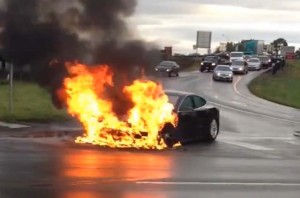The once high-flying Tesla may be coming back to earth; at least its stock is showing signs of being grounded as more and more observers question whether the California-based battery-car maker can justify the phenomenal run-up in its share price since the beginning of the year.
Tesla opened trading on Thursday at $164.50 a share, rising about 2% in the first few hours. While it’s made an impressive six-fold gain when compared to its 52-week low of $27.02, it’s still way below the nearly $200 mark it set in recent weeks before showing signs of coming unplugged.
It didn’t help to have a video land on YouTube showing a new Model S sedan catching fire while driving through the Seattle suburbs. But while Tesla CEO Elon Musk quickly issued a reasonable explanation that downplayed any design flaw with the battery car, the real problem is that a number of influential analysts are becoming increasingly disenchanted and are warning that Tesla stock may be seriously over-priced.
The latest to raise a flag is Bank of America’s John Lovallo, who says his own target price for the stock – which trades on the New York Stock Exchange as TSLA – is a meager $45.
“We have…expressed concern that retail investors could ultimately be at risk, as institutional ownership of Tesla shares continues to wane,” Lovallo said in a pessimistic report on Tesla. “While the recent decline pales in comparison to the year-to-date hyperbolic growth of the shares, it could foreshadow emerging cracks in the seemingly ironclad façade surrounding Tesla’s stock.”
As recently as Sept. 30, Tesla seemed unassailable, its stock soaring to a $194 peak, with many investors still clamoring to get in. There had been a few naysayers in the prior months but their warnings were taken, according to Lovallo, as little more than “howling at the moon.”
Things started to shift when the video showing a Model S in flames suddenly went viral early this month. Auto analyst George Peterson cautioned in an interview with TheDetroitBureau.com that unless this was clearly shown to be due to a vehicle flaw it would likely have little impact, and CEO Musk quickly countered with what he claimed were the facts about the fire.
According to the maker’s own investigation, a large chunk of metal debris managed to punch a three-inch hole in the armor surrounding the battery pack. It was an odd an unlikely occurrence and, Musk noted, the design of the pack kept the fire relatively limited in scope.
But investigators at the National Highway Traffic Safety Administration – who were on furlough due to the government shutdown when the fire occurred – have now launched their own investigation and it is unclear what that may yield. Indeed, shortly after the launch of the Chevrolet Volt, a fire that was later blamed on missteps taken during a routine government crash test nonetheless forced GM to recall early models of the plug-in hybrid to beef up protection of the battery pack.
Even given a clean bill of health by NHTSA, not everyone is sure Tesla will be able to maintain its skyrocketing ascent.
Another skeptical report by R.W. Baird analyst Ben Kallo, which downgraded Tesla shares from “Outperform” to “Neutral,” contributed to an initial 6% decline in Tesla stock. The shares have been jouncing along on a downward trajectory ever since.
(Tesla CEO Musk insists Model S safe in spite of fire. For more, Click Here.)
Observers warn there are several factors that will determine Tesla’s performance in the weeks and months ahead. Long-term, the question remains whether the Model S will continue to gain momentum in the market. The maker is currently on track to sell around 20,000 of the sedans this year. That’s a significant number considering the slow acceptance of battery power in the U.S. market, but European sales have been building far more slowly than Tesla anticipated.
Another key question is whether Tesla will be able to get its second offering, the Model X battery-ute, out the door on schedule next year – and if it will generate anywhere near the interest of the Model S.
(Click Here for details about the impact of the Model S fire.)
Tesla may not be able to wait to reach that milestone, however, if it hopes to reverse the current, downward stock trend. The maker could put investors’ minds at ease when it reports its third-quarter earnings on Nov. 5.
Tesla delivered its first profit during the January – March quarter and surprised analyst by staying in the black the following quarter. More or less, as it used non-GAAP accounting methods and would have been in the loss column by more traditional procedures.
Whether Tesla can prove the naysayers wrong remains to be seen but it needs to halt the current slide even before next month’s earnings announcement.



It should be interesting to see how the financial metrics shake out on tesla when the dust settles. As with Apple stock a lot of people may lose their investment due to euforia instead of good research.